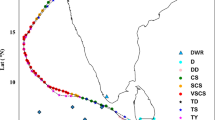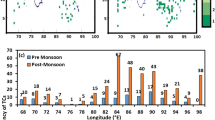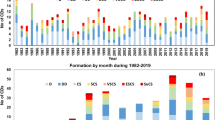Abstract
Despite substantial progress in the tropical cyclone (TC) intensity forecasting, the prediction of rapid intensification (RI) of TCs is still a key challenge to the operational forecasting agencies. Better understanding of the environmental processes associated with RI of TCs would essentially improve its forecasting capability. The physical processes contributing to RI are not well explored in the North Indian Ocean. In this study, the environmental and structural factors associated with RI of an Extremely Severe Cyclonic Storm (ESCS) ‘Tauktae’ over the Arabian Sea are investigated using remote-sensing satellites and Doppler weather radar observations. The TC-Tauktae underwent RI during 16–17 May, 2021, and it has wreaked havoc on India’s western coastal states as it moved parallel to the west coast with track length of about 1180 km. The TC-Tauktae exhibited 61 h of eye scenes during its lifetime, which is more than the eye scenes observed during the super cyclone ‘Amphan’ in May 2020 and double the long period (1982–2015) global average of 30 h. Remote sensing-based eye roundness value and upper tropospheric warm-core anomalies showed promising results for the prediction of TC intensity at very short time scale. In addition, several oceanic and environmental parameters, such as sea surface temperature, tropical cyclone heat potential, vertical wind shear, lower level convergence, upper level divergence, relative vorticity, and total precipitable water content, during different stages of the TC-Tauktae have been analyzed using satellite-derived products to identify their roles during RI of the TC. The findings of this study could serve as supplementary information to enhance the accuracy of operational forecasting of RI of TCs over the North Indian Ocean basins.

(Source: https://www.nrlmry.navy.mil/tc)

(Source: https://rapid.imd.gov.in/rapid/)






Similar content being viewed by others
Data availability
Interested readers can obtain the datasets underlying the findings of this article from the corresponding author on reasonable request.
Change history
29 October 2022
The numbering of section 3.2.2. has been corrected in original article
References
Ahmed R, Mohapatra M, Dwivedi S, Giri RK (2021a) Characteristics features of super cyclone ‘AMPHAN’—observed through satellite images. Tropical Cyclone Res Rev 10:16–31. https://doi.org/10.1016/j.tcrr.2021.03.003
Ahmed R, Mohapatra M, Giri RK, Dwivedi S (2021b) An evaluation of the Advanced Dvorak Technique (9.0) for the tropical cyclones over the North Indian Ocean. Tropical Cyclone Res Rev 10:201–208. https://doi.org/10.1016/j.tcrr.2021.11.003
Ali MM, Jagadeesh PSV, Lin I-I, Hsu J-Y (2012) A neural network approach to estimate tropical cyclone heat potential in the Indian Ocean. IEEE Geosci Remote Sens Lett 9:1114–1117. https://doi.org/10.1109/LGRS.2012.2190491
Baik J-J, Paek J-S (1998) A climatology of sea surface temperature and the maximum intensity of Western North Pacific tropical cyclone. J Meteorol Soc Jpn 76:129–137. https://doi.org/10.2151/jmsj1965.76.1_129
Balachandran S, Nadimpalli R, Osuri KK, Marks FD Jr, Gopalakrishnan S, Subramanian S, Mohanty UC, Niyogi D (2019) On the processes influencing rapid intensity changes of tropical cyclones over the Bay of Bengal. Sci Rep 9:3382. https://doi.org/10.1038/s41598-019-40332-z
Barnes CE, Barnes GM (2014) Eye and eyewall traits as determined with the NOAA WP-3D lower-fuselage radar. Mon Weather Rev 142:3393–3417. https://doi.org/10.1175/MWR-D-13-00375.1
Chen Y, Gao S, Li X, Shen X (2021) Key environmental factors for rapid intensification of the South China Sea tropical cyclones. Front Earth Sci 8:609727. https://doi.org/10.3389/feart.2020.609727
Das AK, Rao YVR, Tallapragada V, Zhang Z, Bhowmik SKR, Sharma A (2015) Evaluation of the Hurricane Weather Research and Forecasting (HWRF) model for tropical cyclone forecasts over the North Indian Ocean (NIO). Nat Hazards 75:1205–1221. https://doi.org/10.1007/s11069-014-1362-6
DeMaria M, Franklin JL, Onderlinde MJ, Kaplan J (2021) Operational forecasting of tropical cyclone rapid intensification at the National Hurricane Center. Atmosphere 12:683. https://doi.org/10.3390/atmos12060683
Deshpande M, Singh VK, Gandhi MK, Roxy MK, Emmanuel R, Kumar U (2021) Changing status of tropical cyclones over the north Indian Ocean. Clim Dyn 57:3545–3567. https://doi.org/10.1007/s00382-021-05880-z
Dvorak VF (1975) Tropical cyclone intensity analysis and forecasting from satellite data. Mon Weather Rev 103:420–430. https://doi.org/10.1175/1520-0493(1975)103%3C0420:TCIAAF%3E2.0.CO;2
Dvorak VF (1984) Tropical cyclone intensity analysis using satellite data, NOAA, Tech. Rep., NESDIS, 11, p44.
Emanuel KA (1986) An air-sea interaction theory for tropical cyclones. Part I: steady-state maintenance. J Atmos Sci 43:585–605
Frank WM, Ritchie EA (1999) Effects of environmental flows upon tropical cyclone structure. Mon Weather Rev 127:2044–2061. https://doi.org/10.1175/1520-0493(1999)127%3C2044:EOEFUT%3E2.0.CO;2
Houze RA Jr, Chen SS, Lee W-C, Rogers RF, Moore JA, Stossmeister GJ, Bell MM, Cetrone J, Zhao W, Brodzik SR (2006) The hurricane rainband and intensity change experiment: observations and modeling of hurricanes Katrina, Ophelia, and Rita. Bull Am Meteor Soc 87:1503–1522. https://doi.org/10.1175/BAMS-87-11-1503
Huang B, Liu C, Banzon V, Freeman E, Graham G, Hankins B, Smith T, Zhang H-M (2021) Improvements of the daily optimum interpolation sea surface temperature (DOISST) version 2.1. J Clim 34:2923–2939. https://doi.org/10.1175/JCLI-D-20-0166.1
IMD, 2013: Cyclone warning in India: Standard Operation Procedure. IMD, New Delhi
Jaiswal N, Kishtawal CM (2013) Objective detection of center of tropical cyclone in remotely sensed infrared images. IEEE J Selected Topics Appl Earth Observ Remote Sens 6:1031–1135. https://doi.org/10.1109/JSTARS.2012.2215016
Jangir B, Swain D, Ghose SK (2021) Influence of eddies and tropical cyclone heat potential on intensity changes of tropical cyclones in the North Indian Ocean. Adv Space Res 68:773–786. https://doi.org/10.1016/j.asr.2020.01.011
Kaplan J, DeMaria M (2003) Large-scale characteristics of rapidly intensifying tropical cyclones in the North Atlantic basin. Weather Forecast 18(6):1093–1108. https://doi.org/10.1175/1520-0434(2003)018%3C1093:LCORIT%3E2.0.CO;2
Kaplan J, Rozoff CM, DeMaria M, Sampson CR, Kossin JP, Velden CS, Cione JJ, Dunion JP, Knaff JA, Zhang JA, Dostalek JF, Hawkins JD, Lee TF, Solbrig JE (2015) Evaluating environmental impacts on tropical cyclone rapid intensification predictability utilizing statistical models. Weather Forecast 30(5):1374–1396. https://doi.org/10.1175/WAF-D-15-0032.1
Kashyap T, T.D.V.P. Rao, S. Agarwal, M. Arulraj, and M.M. Ali, (2012) Estimation of tropical cyclone heat potential on operational basis. Technical Report, National Remote Sensing Centre, Hyderabad, India. NRSC-ECSA-AOSG-Sept2012-TR-442.
Kidder SQ, Goldberg MD, Zehr RM, DeMaria M, Purdom JFW, Velden CS, Grody NC, Kusselson SJ (2000) Satellite analysis of tropical cyclones using the advanced microwave sounding unit (AMSU). Bull Am Meteor Soc 81:1241–1260. https://doi.org/10.1175/1520-0477(2000)081%3C1241:SAOTCU%3E2.3.CO;2
Kishtawal CM, Shah S, Chaurasia S, Jaiswal N (2013) A simple model for post-landfall intensity changes of tropical cyclone over India, Bangladesh and Myanmar coasts. J Earth Syst Sci 122:967–977. https://doi.org/10.1007/s12040-013-0315-x
Knapp KR, Velden CS, Wimmers AJ (2018) A global climatology of tropical cyclone eyes. Mon Weather Rev 146:2089–2101. https://doi.org/10.1175/MWR-D-17-0343.1
Kotal SD, Bhowmik SKR (2013) Large-scale characteristics of rapidly intensifying tropical cyclones over the Bay of Bengal and a rapid intensification (RI) index. Mausam 64:13–24. https://doi.org/10.54302/mausam.v64i1.651
Kotal SD, Bhowmik SKR, Kundu PK, Das AK (2008) A statistical cyclone intensity prediction (SCIP) model for the Bay of Bengal. J Earth Syst Sci 117:157. https://doi.org/10.1007/s12040-008-0006-1
Kowch R, Emanuel K (2015) Are special processes at work in the rapid intensification of tropical cyclones? Mon Weather Rev 143:878–882. https://doi.org/10.1175/MWR-D-14-00360.1
Lander MA (1999) A tropical cyclone with a very large eye. Mon Weather Rev 127:137–142. https://doi.org/10.1175/1520-0493(1999)127%3C0137:ATCWAV%3E2.0.CO;2
Leipper DF, Volgenau D (1972) Hurricane heat potential of the Gulf of Mexico. J Phys Oceanogr 2:218–224. https://doi.org/10.1175/1520-0485(1972)002%3C0218:HHPOTG%3E2.0.CO;2
Lyu X, Wang X, Leslie LM (2019) The dependence of Northwest Pacific tropical cyclone intensification rates on environmental factors. Adv Meteorol. https://doi.org/10.1155/2019/9456873
Merrill RT (1988) Environmental influences on hurricanes intensification. J Atmos Sci 45:1678–1687. https://doi.org/10.1175/1520-0469(1988)045%3C1678:EIOHI%3E2.0.CO;2
Mitra AK, Bohra AK, Rajeevan MN, Krishnamurti TN (2009) Daily Indian precipitation analysis formed from a merge of rain-gauge data with the TRMM TMPA satellite-derived rainfall estimates. J Meteorol Soc Jpn 87A:265–279. https://doi.org/10.2151/jmsj.87A.265
Mohanty UC, Osuri KK, Routray A, Mohapatra M, Pattanayak S (2010) Simulation of Bay of Bengal tropical cyclones with WRF model: impact of initial and boundary conditions. Mar Geodesy 33:294–314. https://doi.org/10.1080/01490419.2010.518061
Mohapatra M (2015) Cyclone hazard proneness of districts of India. J Earth Syst Sci 124:515–526. https://doi.org/10.1007/s12040-015-0556-y
Mohapatra M, Sharma M (2019) Cyclone warning services in India during recent years: a review. Mausam 70:635–666. https://doi.org/10.54302/mausam.v70i4.204
Mohapatra M, Sharma M (2021) Comparative analysis of vital parameters of extremely severe cyclonic storms Phailin and Hudhud over the Bay of Bengal. J Earth Syst Sci 130:233. https://doi.org/10.1007/s12040-021-01719-7
Mohapatra M, Bandyopadhyay BK, Tyagi A (2012) Best track parameters of tropical cyclones over the North Indian Ocean: a review. Nat Hazards 63:1285–1317. https://doi.org/10.1007/s11069-011-9935-0
Mohapatra M, Nayak DP, Sharma RP, Bandyopadhyay BK (2013) Evaluation of official tropical cyclone track forecast over north Indian Ocean issued by India Meteorological Department. J Earth Syst Sci 122:589–601. https://doi.org/10.1007/s12040-013-0291-1
Mohapatra M, Sharma M, Devi SS, Kumar SVJ, Sabade BS (2021a) Frequency of genesis and landfall of different categories of tropical cyclones over the North Indian Ocean. Mausam 72:1–26. https://doi.org/10.54302/mausam.v72i1.119
Mohapatra M, Mitra AK, Singh V, Mukherjee SK, Navria K, Prashar V, Tyagi A, Verma AK, Devi S, Prasad VS, Ramesh M, Kumar R (2021b) INSAT-3DR-rapid scan operations for weather monitoring over India. Curr Sci 120:1026–1034. https://doi.org/10.18520/cs/v120/i6/1026-1034
Nadimpalli R, Osuri KK, Mohanty UC, Das AK, Kumar A, Sil S, Niyogi D (2019) Forecasting tropical cyclones in the Bay of Bengal using quasi-operational WRF and HWRF modeling systems: an assessment study. Meteorol Atmos Phys 132:1–17. https://doi.org/10.1007/s00703-019-00669-6
Nadimpalli R, Mohanty S, Pathak N, Osuri KK, Mohanty UC, Chatterjee S (2021) Understanding the characteristics of rapid intensity changes of tropical cyclones over North Indian Ocean. SN Appl Sci 3:68. https://doi.org/10.1007/s42452-020-03995-2
Osuri KK, Mohanty UC, Routray A, Mohapatra M (2012) The impact of satellite-derived wind data assimilation on track, intensity and structure of tropical cyclones over the North Indian Ocean. Int J Remote Sens 33:1627–1652. https://doi.org/10.1080/01431161.2011.596849
Prakash S, Mitra AK, Gairola RM, Norouzi H, Pai DS (2018) Status of high-resolution multisatellite precipitation products across India. In: Islam T, Hu Y, Kokhanovsky A, Wang J (eds) Remote sensing of aerosols, clouds, and precipitation. Elsevier, pp 301–314. https://doi.org/10.1016/B978-0-12-810437-8.00014-1
Qian Y, Zhang S (2013) Cause of the rapid weakening of typhoon Bebinca (0021) in the South China Sea. Trop Cyclone Res Rev 2:159–168. https://doi.org/10.6057/2013TCRR03.03
Rao AD, Babu SV, Dube SK (2004) Impact of a tropical cyclone on coastal upwelling processes. Nat Hazards 31:415–435. https://doi.org/10.1023/B:NHAZ.0000023360.37260.5b
RSMC, 2021: Extremely severe cyclonic storm TAUKTAE over the Arabian Sea (14th–19th May, 2021): a report. Cyclone Warning Division, India Meteorological Department, New Delhi, pp. 65. 15 Dec, 2021. https://rsmcnewdelhi.imd.gov.in/uploads/report/26/26_e0cc1a_Preliminary%20Report%20on%20ESCS%20TAUKTAE-19july.pdf.
Ryglicki DR, Cossuth JH, Hodyss D, Doyle JD (2018) The unexpected rapid intensification of tropical cyclones in moderate vertical wind shear. Part I: overview and observations. Mon Weather Rev 146:3773–3800. https://doi.org/10.1175/MWR-D-18-0020.1
Singh V, Koll R (2022) A review of ocean-atmosphere interactions during tropical cyclones in the north Indian Ocean. Earth Sci Rev 226(3):103967. https://doi.org/10.1016/j.earscirev.2022.103967
Singh D, Bhatia RC, Srivastava SK (2004) Satellite analysis of tropical cyclones using NOAA-16 AMSU measurements over Indian region. Mausam 55:149–154. https://doi.org/10.54302/mausam.v55i1.962
Singh SK, Kishtawal CM, Pal PK (2012) Track prediction of Indian Ocean cyclones using Lagrangian advection model. Nat Hazards 62:745–778. https://doi.org/10.1007/s11069-012-0121-9
Stern DP, Vigh JL, Nolan DS, Zhang F (2015) Revisiting the relationship between eyewall contraction and intensification. J Atmos Sci 72:1283–1306. https://doi.org/10.1175/JAS-D-14-0261.1
Velden CS, Olander TL, Zehr RM (1998) Development of an objective scheme to estimate tropical cyclone intensity from digital geostationary satellite infrared imagery. Weather Forecast 13:172–186. https://doi.org/10.1175/1520-0434(1998)013%3C0172:DOAOST%3E2.0.CO;2
Velden C, Harper B, Wells F, Beven JL II, Zehr R, Olander T, Mayfield M, Guard CC, Lander M, Edson R, Avila L, Burton A, Turk M, Kikuchi A, Christian A, Caroff P, McCrone P (2006) The Dvorak tropical cyclone intensity estimation technique: a satellite-based method that has endured for over 30 years. Bull Am Meteor Soc 87:1195–1210. https://doi.org/10.1175/BAMS-87-9-1195
Vigh JL, Knaff JA, Schubert WH (2012) A climatology of hurricane eye formation. Mon Weather Rev 140:1405–1426. https://doi.org/10.1175/MWR-D-11-00108.1
Vinodhkumar B, Busireddy NKR, Ankur K, Nadimpalli R, Osuri KK (2021) On occurrence rapid of intensification and rainfall changes in tropical cyclones over the North Indian Ocean. Int J Climatol. https://doi.org/10.1002/joc/7268
Wahiduzzaman Md, Cheung KK, Luo J-J, Bhaskaran PK (2022) A spatial model for predicting North Indian Ocean tropical cyclone intensity: role of sea surface temperature and tropical cyclone heat potential. Weather Clim Extremes 36:100431. https://doi.org/10.1016/j.wace.2022.100431
Wang X, Jiang H (2021) Contrasting behaviors between the rapidly intensifying and slowly intensifying tropical cyclones in the North Atlantic and Eastern Pacific basins. J Clim 34:987–1003. https://doi.org/10.1175/JCLI-D-19-0908.1
Wimmers AJ, Velden CS (2011) Seamless advective blending of total precipitable water retrievals from polar-orbiting satellites. J Appl Meteorol Climatol 50:1024–1036. https://doi.org/10.1175/2010JAMC2589.1
Wu Y, Chen S, Li W, Fang R, Liu H (2020) Relative vorticity is the major environmental factor controlling tropical cyclone intensification over the Western North Pacific. Atmos Res 237:104874. https://doi.org/10.1016/j.atmosres.2020.104874
Zhu X, Li Q, Yu J, Wu D, Yao K (2018) Geometric characteristics of tropical cyclone eyes before landfall in South China based on ground-based radar observations. Adv Atmos Sci 35:592–603. https://doi.org/10.1007/s00376-017-7144-9
Acknowledgements
The authors would also like to thank the Cyclone Warning, Satellite Meteorology, and Radar Divisions of IMD for providing the relevant data and images used in this study. The use of NOAA-CIMSS satellite-based products, US NAVY-NRL passive microwave satellite images, NOAA reanalysis data, and TCHP data from the NRSC, ISRO are thankfully acknowledged. The authors also thank the editor and anonymous reviewers for their constructive comments. The contents and views expressed in the document are the views of the contributors and do not necessarily reflect the views of the organization they belong to.
Author information
Authors and Affiliations
Corresponding author
Ethics declarations
Conflict of interest
The authors declare no conflict of interest.
Additional information
Editorial responsibility: Clemens Simmer.
Publisher's Note
Springer Nature remains neutral with regard to jurisdictional claims in published maps and institutional affiliations.
Rights and permissions
Springer Nature or its licensor (e.g. a society or other partner) holds exclusive rights to this article under a publishing agreement with the author(s) or other rightsholder(s); author self-archiving of the accepted manuscript version of this article is solely governed by the terms of such publishing agreement and applicable law.
About this article
Cite this article
Ahmed, R., Prakash, S., Mohapatra, M. et al. Understanding the rapid intensification of extremely severe cyclonic storm ‘Tauktae’ using remote-sensing observations. Meteorol Atmos Phys 134, 97 (2022). https://doi.org/10.1007/s00703-022-00935-0
Received:
Accepted:
Published:
DOI: https://doi.org/10.1007/s00703-022-00935-0






